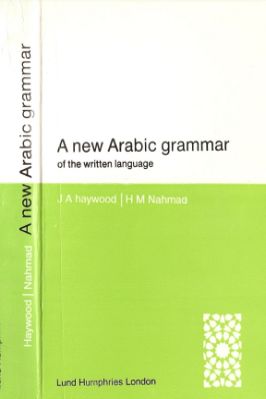
| Book Title | A New Arabic Grammar Of The Written Language |
| Book Author | |
| Total Pages | 708 |
| Book Views | |
| Language | English |
| Read Online | Read this Book Online |
| Book Download | PDF Direct Download Link |
| Get Hardcover | Click for Hard Copy from Amazon |
A New Arabic Grammar of the Written Language: Book by John A. Haywood
A NEW ARABIC GRAMMAR OF THE WRITTEN LANGUAGE
- The Arabic Language. Orthography. Phonetics. Punctuation
- The Article. The Simple Nominal Sentence
- Gender. The Feminine
- Declension of Nouns. The Three Cases
- Number. The Sound Masculine and Feminine Plurals. Some Simple Verb Forms
- The Broken Plural
- The Broken Plural (continued)
- The Genitive (‘Iḍāfa)
- The Attached Pronouns
- Demonstrative Pronouns
- Adjectives
- The Verb
- The Verb with Pronoininal Object. The Verb “to be”
- The Imperfect
- Moods of the Imperfect. The subjunctive
- Moods of the Imperfect. The Jussive
- The Imperative
- The Passive Verb
- Derived Forms of the Triliteral Verb. General Introduction
- Derived Forms of the Triliteral Verb, 11, 11. and IV
- Forms V and VI
- Forms VII and VIII
- Forms IX, X and XI
- Irregular Verbs. The Doubled Verb
- Hamzated Verbs. Hamza as Initial Radical
- Weak Verbs. The Assimilated Verb
- The Hollow Verb
- The Verb with Weak Final Radical
- The Doubly and Trebly Weak Verb
- The Quadriliteral Verb
- Various Unorthodox Verbs
- How to Use an Arabic Dictionary
- Relative Sentences
- Conditional Sentences
- The Cardinal Numbers. Time. Dates
- The Ordinal Numbers. Fractions
- The Structure of Arabic Noun Forms
- Noun Forms. The Noun of Place and Time. The Noun of Instrument. The Diminutive
- The Relative Noun and Adjective. Various Adjectival Forms
- Abstract Nouns. Proper Names. The Feminine
- Number
- Declension of Nouns
- The Use of the Cases
- The Permutative
- Particles. Prepositions
- Adverbial Usages, including miscellaneous quasi-adverbial particles
- Particles. Conjunctions
- Particles. Interjections
- Exception
- The Rules of Arabic Versification
- Supplement. (Specimens from Arabic Literature)
- Appendix A: Colloquial Arabic Dialects
- B: Guide to Further Study
- C: Supplementary Grammatical Notes
- Vocabulary, Arabic-English
- Grammatical Index.
Book Description
“A New Arabic Grammar of the Written Language” by John A. Haywood is a comprehensive and indispensable resource for students seeking to master the intricacies of the Arabic language. With a clear and organized structure, this book covers a wide range of grammatical topics, starting from the fundamentals of orthography, phonetics, and punctuation. The journey through the Arabic language unfolds chapter by chapter, guiding learners through essential concepts like the article, gender, declension of nouns, and the formation of sound masculine and feminine plurals.
This grammar delves into the complexities of the verb system, offering detailed explanations of various verb forms, including the imperfect tense, subjunctive, jussive, and imperative moods. The passive verb and derived forms of the triliteral verb receive thorough attention, empowering learners to navigate these crucial aspects of Arabic grammar with confidence. The book also explores irregular verbs, hamzated verbs, weak verbs, and the unique quadriliteral verb, unveiling the nuances and patterns of these forms.
To aid in vocabulary acquisition, the authors thoughtfully include a basic vocabulary of approximately 4,000 words drawn from classical and modern sources. The carefully selected vocabulary is designed to support learners in their journey, and each chapter has its own vocabulary list for easy reference. Additionally, a consolidated vocabulary at the end of the book helps students review and reinforce their learning.
The authors recognize the importance of practical application in language learning. As such, the book is replete with sentences and exercises that exemplify grammatical points, facilitating comprehension and retention. These sentences, though not necessarily artistically crafted, serve their educational purpose admirably. Moreover, a substantial supplement presents extracts from both classical and modern literature, offering students exposure to authentic language usage in context.
In acknowledging the diverse needs of learners, the book is thoughtfully organized to ensure accessibility. The authors understand that bombarding learners with exhaustive rules can be overwhelming. Therefore, the presentation of grammatical topics follows a logical progression but is also mindful of the convenience of the student. The space dedicated to individual grammatical points is carefully calibrated based on the authors’ experience as educators, making the learning process smoother and more manageable.
Although the task of compiling such a comprehensive grammar is formidable, the authors are candid about the possibility of occasional errors and differences of opinion. Nonetheless, they remain dedicated to improving their work and welcome feedback from readers for future editions.
In conclusion, “A New Arabic Grammar of the Written Language” is an invaluable tool for students and instructors alike. Through its systematic approach, comprehensive coverage, and practical exercises, this book equips learners with the necessary skills to navigate the Arabic language with proficiency and confidence. Whether in a classroom or self-study setting, this grammar stands as a reliable and insightful companion on the journey to mastering the beauty and complexity of the Arabic written language.
To read more about the A New Arabic Grammar Of The Written Language book Click the download button below to get it for free
or
 Don't Miss out any Book Click Join OpenMaktaba Telegram group
Don't Miss out any Book Click Join OpenMaktaba Telegram group